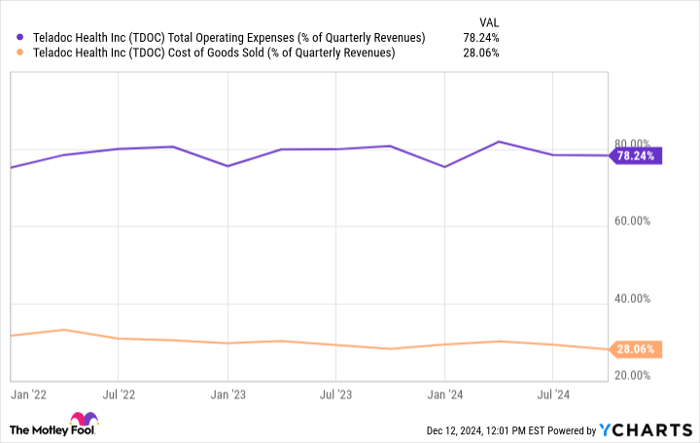Like all companies, Teladoc Health (NYSE: TDOC) will need to evolve a lot over the next three years. The days of the telehealth operator's peak hype are now firmly in the past. It's up to management to deliver good returns to the shareholders through prudent execution of its core strategy, rather than marketing alone.
What will that look like in practice, and what should investors be on the lookout for? Let's examine a pair of scenarios and map out this business' future.
Will the company's direction change?
There are two main possibilities for where Teladoc will be in late 2027.
In one of those scenarios, the business will spend the next couple of years consolidating its market share in telehealth, seeking to shore up an ecosystem of services that subscribers and insurers will find beneficial to participate in, instead of defecting to a competitor.
While rolling out a few new services will likely be necessary for ongoing growth in its subscriber base and its revenue, the main focus will be on building up a competitive advantage via the economies of scale it may have in delivering telehealth. Teladoc would thus seek to retain its large volume of recurring revenue from monthly payments from its members, and seek to upsell them on additional offerings for additional fees.
It might also find some growth by fully realizing its strategy to create virtual primary healthcare service, as well as its chronic care management service. Smoothly integrating data from a patient's medical records and at-home medical sensors may become competitive differentiators. Profitability wouldn't be a major concern, at least not immediately.
The other scenario takes a different approach. Rather than continuing to try to compete further down the care chain in primary care, behavioral health, and other specialties, Teladoc could embrace its strong position at the top of the funnel and double down on using its telehealth services as the public's first (or only) stop in their care journey.
In this scenario, the company would aim to get even better at helping patients to understand whether or not they need to urgently go to an in-person doctor or specialist, and at dispatching prescriptions and organizing follow-ups with primary care for common issues.
In financial terms, the focus would be on controlling its cost of delivering care and building up its margins by eliminating activities that it didn't excel at. The business would probably become operationally profitable sooner than in the first scenario.
In June, Teladoc got a new CEO, Chuck Divita, who also joined the company's board of directors at the same time. So far, he hasn't yet mentioned either of these scenarios, but it's worth mentioning that the first scenario is the one that guided strategy during the prior CEO's tenure.
Still, the second scenario might end up being more favorable for shareholders. Teladoc's quarterly gross margin is 67.2% as of the third quarter, slightly lower than in the same quarter a year ago. Though its membership base has grown to reach 93.9 million people in the same period, its quarterly revenue shrank by 3%, reaching $640.5 million.
In other words, the strategy of creating more telehealth services for members to use hasn't resulted in the top line growing consistently, nor has it done the margin any favors. While it may be true that the company could one day realize efficiencies due to the scale of its operations, those haven't panned out yet, and there isn't evidence that they are about to do so.
Look at this chart depicting Teladoc's total quarterly operating expenses and its cost of goods sold (COGS) expressed as a percentage of revenue.
TDOC Total Operating Expenses (% of Quarterly Revenues) data by YCharts.
There's a clear incentive for the new leadership to take a different approach. If that approach succeeds in actually lowering costs and thereby delivering the second scenario, Teladoc could potentially be profitable three years from now (or sooner).
There's more than one risk in store
For investors today, there are a few risks inherent to each of Teladoc's possible futures although they don't entail risks that would be likely to sink the company altogether.
In particular, the biggest risk is that major, mission critical, and ongoing costs, such as for physician labor, simply can't be reduced significantly. Doctors are unlikely to work for less than their market rate, which is expensive. Equipping them with additional technology probably won't change that fact.
Another big risk is that the business won't be able to develop a moat to prevent its market share from flowing freely to competitors. From the perspective of a member, telehealth services are just a means to the end of talking with a clinician. If it isn't crystal clear to members what additional value they're getting by paying Teladoc instead of another player with a lower subscription price, they don't have much reason to stick around.
Should you invest $1,000 in Teladoc Health right now?
Before you buy stock in Teladoc Health, consider this:
The Motley Fool Stock Advisor analyst team just identified what they believe are the 10 best stocks for investors to buy now… and Teladoc Health wasn’t one of them. The 10 stocks that made the cut could produce monster returns in the coming years.
Consider when Nvidia made this list on April 15, 2005... if you invested $1,000 at the time of our recommendation, you’d have $822,755!*
Stock Advisor provides investors with an easy-to-follow blueprint for success, including guidance on building a portfolio, regular updates from analysts, and two new stock picks each month. The Stock Advisor service has more than quadrupled the return of S&P 500 since 2002*.
*Stock Advisor returns as of December 9, 2024
Alex Carchidi has no position in any of the stocks mentioned. The Motley Fool has positions in and recommends Teladoc Health. The Motley Fool has a disclosure policy.
The views and opinions expressed herein are the views and opinions of the author and do not necessarily reflect those of Nasdaq, Inc.



